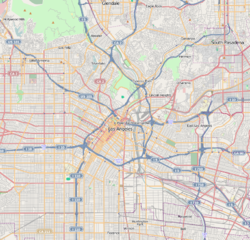Little Tokyo, Los Angeles
|
Little Tokyo Historic District
|
|

The Far East Café (Chop Suey), a landmark 1896 Beaux-Arts building
|
|
| Location | Los Angeles, California, United States |
|---|---|
| Coordinates | 34°3′2″N 118°14′22″W / 34.05056°N 118.23944°WCoordinates: 34°3′2″N 118°14′22″W / 34.05056°N 118.23944°W |
| Built | 1942 |
| Architect | Edgar Cline, Et al. |
| NRHP Reference # | 86001479 |
| Significant dates | |
| Added to NRHP | August 22, 1986 |
| Designated NHLD | June 12, 1995 |
Little Tokyo, also known as Little Tokyo Historic District, is an ethnically Japanese American district in downtown Los Angeles and the heart of the largest Japanese-American population in North America. It is one of only three official Japantowns in the United States, all in California (the other two are in San Francisco and San Jose). Founded around the beginning of the 20th century, the area, sometimes called Lil' Tokyo, J-Town, 小東京 (Shō-tōkyō), is the cultural center for Japanese Americans in Southern California. It was declared a National Historic Landmark District in 1995.
In 1905 the area of "Little Tokyo" was described as "bounded by San Pedro, First and Requena streets and Central avenue. The Los Angeles Times added: "It has a population of about 3500 Japanese, with quite a colony of Jews and Russians and a few Americans. . . . there are 10,000 Japanese in the city who make this section their rendezvous."
The area was a magnet for immigrating Japanese until the Exclusion Act of 1924 halted any further migration. Shops were along First Street, and vegetable markets were along Central Avenue to the south. Japanese Americans were a significant ethnic group in the vegetable trade, due to the number of successful Japanese American truck farms across Southern California. In 1941, there were approximately 30,000 Japanese Americans living in Little Tokyo.
The incarceration of Japanese Americans during World War II emptied Little Tokyo. For a brief time, the area became known as Bronzeville as African Americans and also Native Americans and Latinos moved into the vacated properties and opened up nightclubs, restaurants, and other businesses. Beginning in 1942, after the city's Japanese population was rounded up and "evacuated" to inland concentration camps, a large number of African Americans moved to Los Angeles to find work in the labor-starved defense industry. Its share in the Great Migration almost tripled Little Tokyo's pre-war population, with some 80,000 new arrivals taking up residence there. Prohibited from buying and renting in most parts of the city by restrictive covenants, the area soon became severely overcrowded. A single bathroom was often shared by up to 40 people and one room could house as many as 16; people frequently shared "hot beds," sleeping in shifts. Poor housing conditions helped spread communicable illnesses like tuberculosis and venereal disease. Crimes like robberies, rapes, and hit-and-run accidents increased, and in May and June 1943 Latino and some African American residents of Bronzeville were attacked by whites in the Zoot Suit race riots. In 1943, officials bowed to pressure from frustrated residents and proposed building temporary housing in nearby Willowbrook, but the majority-white residents of the unincorporated city resisted the plans. In 1944, 57 Bronzeville buildings were condemned as unfit for habitation and 125 ordered repaired or renovated; approximately 50 of the evicted families were sent to the Jordan Downs housing complex. In 1945, many defense industry jobs disappeared and the workers moved elsewhere in search of new employment. Others were pushed out when Japanese Americans began to return and white landlords chose not to renew leases with their wartime tenants.
...
Wikipedia

